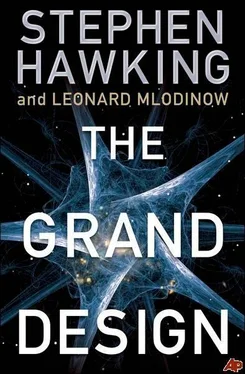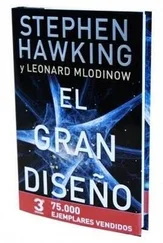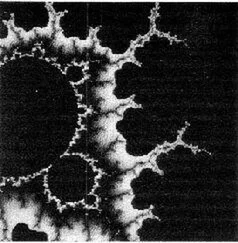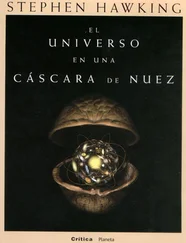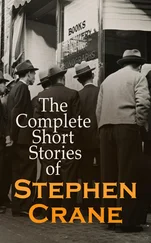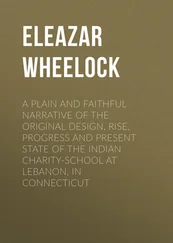The question of whether it makes sense to say quarks really exist if you can never isolate one was a controversial issue in the years after the quark model was first proposed. The idea that certain particles were made of different combinations of a few sub-subnuclear particles provided an organizing principle that yielded a simple and attractive explanation for their properties. But although physicists were accustomed to accepting particles that were only inferred to exist from statistical blips in data pertaining to the scattering of other particles, the idea of assigning reality to a particle that might be, in principle, unobservable was too much for many physicists. Over the years, however, as the quark model led to more and more correct predictions, that opposition faded. It is certainly possible that some alien beings with seventeen arms, infrared eyes, and a habit of blowing clotted cream out their ears would make the same experimental observations that we do, but describe them without quarks. Nevertheless, according to model-dependent realism, quarks exist in a model that agrees with our observations of how subnuclear particles behave.
Model-dependent realism can provide a framework to discuss questions such as: If the world was created a finite time ago, what happened before that? An early Christian philosopher, St. Augustine (354-430), said that the answer was not that God was preparing hell for people who ask such questions, but that time was a property of the world that God created and that time did not exist before the creation, which he believed had occurred not that long ago. That is one possible model, which is favored by those who maintain that the account given in Genesis is literally true even though the world contains fossil and other evidence that makes it look much older. (Were they put there to fool us?) One can also have a different model, in which time continues back 13.7 billion years to the big bang. The model that explains the most about our present observations, including the historical and geological evidence, is the best representation we have of the past. The second model can explain the fossil and radioactive records and the fact that we receive light from galaxies millions of light-years from us, and so this model-the big bang theory-is more useful than the first. Still, neither model can be said to be more real than the other.
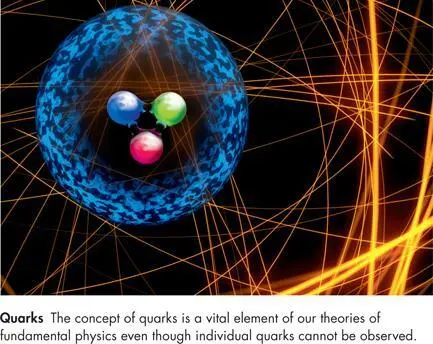
Some people support a model in which time goes back even further than the big bang. It is not yet clear whether a model in which time continued back beyond the big bang would be better at explaining present observations because it seems the laws of the evolution of the universe may break down at the big bang. If they do, it would make no sense to create a model that encompasses time before the big bang, because what existed then would have no observable consequences for the present, and so we might as well stick with the idea that the big bang was the creation of the world.
A model is a good model if it:
1. Is elegant
2. Contains few arbitrary or adjustable elements
3. Agrees with and explains all existing observations
4. Makes detailed predictions about future observations that can disprove or falsify the model if they are not borne out.
For example, Aristotle’s theory that the world was made of four elements, earth, air, fire, and water, and that objects acted to fulfill their purpose was elegant and didn’t contain adjustable elements. But in many cases it didn’t make definite predictions, and when it did, the predictions weren’t always in agreement with observation. One of these predictions was that heavier objects should fall faster because their purpose is to fall. Nobody seemed to have thought that it was important to test this until Galileo. There is a story that he tested it by dropping weights from the Leaning Tower of Pisa. This is probably apocryphal, but we do know he rolled different weights down an inclined plane and observed that they all gathered speed at the same rate, contrary to Aristotle’s prediction.
The above criteria are obviously subjective. Elegance, for example, is not something easily measured, but it is highly prized among scientists because laws of nature are meant to economically compress a number of particular cases into one simple formula. Elegance refers to the form of a theory, but it is closely related to a lack of adjustable elements, since a theory jammed with fudge factors is not very elegant. To paraphrase Einstein, a theory should be as simple as possible, but not simpler. Ptolemy added epicycles to the circular orbits of the heavenly bodies in order that his model might accurately describe their motion. The model could have been made more accurate by adding epicycles to the epicycles, or even epicycles to those. Though added complexity could make the model more accurate, scientists view a model that is contorted to match a specific set of observations as unsatisfying, more of a catalog of data than a theory likely to embody any useful principle.
We’ll see in Chapter 5 that many people view the “standard model,” which describes the interactions of the elementary particles of nature, as inelegant. That model is far more successful than Ptolemy’s epicycles. It predicted the existence of several new particles before they were observed, and described the outcome of numerous experiments over several decades to great precision. But it contains dozens of adjustable parameters whose values must be fixed to match observations, rather than being determined by the theory itself.
As for the fourth point, scientists are always impressed when new and stunning predictions prove correct. On the other hand, when a model is found lacking, a common reaction is to say the experiment was wrong. If that doesn’t prove to be the case, people still often don’t abandon the model but instead attempt to save it through modifications. Although physicists are indeed tenacious in their attempts to rescue theories they admire, the tendency to modify a theory fades to the degree that the alterations become artificial or cumbersome, and therefore “inelegant.”
If the modifications needed to accommodate new observations become too baroque, it signals the need for a new model. One example of an old model that gave way under the weight of new observations was the idea of a static universe. In the 1920s, most physicists believed that the universe was static, or unchanging in size. Then, in 1929, Edwin Hubble published his observations showing that the universe is expanding. But Hubble did not directly observe the universe expanding. He observed the light emitted by galaxies. That light carries a characteristic signature, or spectrum, based on each galaxy’s composition, which changes by a known amount if the galaxy is moving relative to us. Therefore, by analyzing the spectra of distant galaxies, Hubble was able to determine their velocities. He had expected to find as many galaxies moving away from us as moving toward us. Instead he found that nearly all galaxies were moving away from us, and the farther away they were, the faster they were moving. Hubble concluded that the universe is expanding, but others, trying to hold on to the earlier model, attempted to explain his observations within the context of the static universe. For example, Caltech physicist Fritz Zwicky suggested that for some yet unknown reason light might slowly lose energy as it travels great distances. This decrease in energy would correspond to a change in the light’s spectrum, which Zwicky suggested could mimic Hubble’s observations. For decades after Hubble, many scientists continued to hold on to the steady-state theory. But the most natural model was Hubble’s, that of an expanding universe, and it has come to be the accepted one.
Читать дальше
